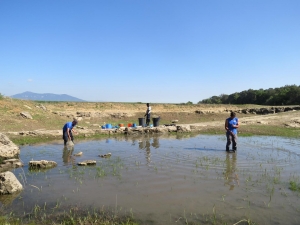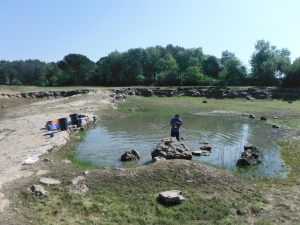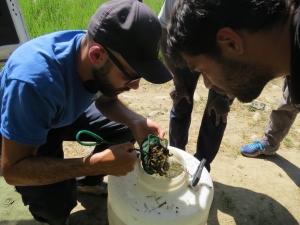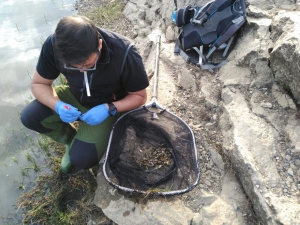Amphibian tadpoles are rescuted in “Clot d’Espolla” by technicians of Consorci de l’Estany
- The rescue took place in the pond of the Espolla on April the 12th, a day before it completely dried out - The rescued tadpoles have been released at the lagoons of Can Morgat in Porqueres and at the new ponds of Llémena river, under the Potamo Fauna project - This action was done in compliance with a protocol to prevent the proliferation of diseases of amphibians and the corresponding authorizations from the Department of Territori i Sostenibilitat of the Generalitat of Catalunya and in co-operation with the Research Group of Escola de Natura de l’Ajuntament de Parets del Vallès
The Clot d’Espolla is a temporary pond water located in the municipalities of Fontcoberta and Porqueres, and is part of the protected area of the Estany de Banyoles, inlcuded in the Nature 2000 Network. Is filled from ground water after heavy rains by the aquifer that feeds the lake area of the lake in Banyoles. Once filled aquatic interesting and protected especies breed, as an ancient crustacean called Triops cancriformis and some species of amphibians. On 13th February 2017 after two days of heavy rain the pond of Espolla filled up, after three and a half years without doing it and the flooding lasted two months. In this period the pond held up five species of amphibians: Hyla meridionalis, Bufa calamita, Pelobates cultripes, Pelodytes punctatus and Discoglossus pictus.
In anticipation of the total drying of the pond in a few weeks and the presence of numerous tadpoles, especially from Pelobates cultripes, a protected species that requires very long flooding to finish their metamorphosis, it was decided to organize a rescue. The premature drying of the pond would have caused irreparable death of amphibians, most of whom would not have completed the process of metamorphosis. Although this is a natural fact, the plight of amphibians advised to make conservation actions like this and move the tadpoles recovered in other areas where they can fully develop. Spur toad populations are in decline and in a situation of great concern for preserving the surrounding region. Their populations are isolated and with just a few individuals.
On April the 12th, when there were only 20 cm. water in the pond, the action was carried out by four rescue operators of the Consorci de l’Estany. Up to 60,000 tadpoles were collected, particularly Discoglossus pictus, but also Pelobates cultripes. The proportion of 80-85% Pelodytes punctatus, 10-15% Pelobates cultripes, 0-1% and others, such as the Common Midwife Toad (Alytes obstetricans). Individuals of Triops cancriformis were located, and the tadpoles were separated and returned to the pond. Some juveniles of small frogs were also observed and were left in the water, which was collected.
In general, amphibians are suffering a dramatic regression, due to the loss of breeding areas, destruction of wetlands, the effects of climate change, the impact of exotic species and the emergence of new diseases such as ranavirus or quitridimidiosis. To prevent the spread of infectious diseases that are causing negative effects on amphibian populations a study of the state of health of tadpoles was done. Experts from the research group of the Escola de Natura de Parets del Vallès previously did an analysis of the pathologies of the rescued tadpoles to rule out the presence of ranavirus and quitridimidiosi. The analysis was done through a genetic study, the PCR technique, which is made in Germany. The results were negative, giving approval to make the translocation to new locations.
The pathogen is ranavirus shaped and causes ulcer and hemorrhagic syndrome, dermatitis and small multifocal hemorrhages affecting the subcutaneous tissue of the plantar surface of the foot of amphibians. Regarding the quitridimidiosi is an infectious disease of amphibians, caused by the fungus Batrachochytrium quitridi. There is no effective measure to control the disease in wild populations. The disease is contributing to a decline in amphibian populations.
The individuals that have been rescued have been released in the lagoons of Can Morgat in Porqueres near the lake of Banyoles and a newly created ponds around the Llémena river near its mouth. The ponds have been created by the Consorci del Ter thanks to the LIFE Potamo Fauna (www.lifepotamofauna.org) project. The release of those amphibians is also part of the actions to improve amphibian populations and the rivers Ter and Llémena.
The action has been authorized by the Department of Territori and Sostenibilitat of the Generalitat of Catalunya and several rangers (Agents Rurals), have supervised the coordination.





















